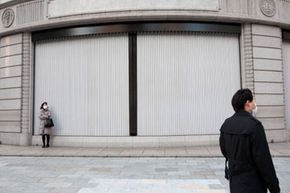Fukushima Daiichi Nuclear Plant Crisis
Nuclear reactor designers build safeguards based on a probabilistic assessment, in which they try to balance the potential harm from an event with the likelihood of it actually occurring [source: Nuclear Regulatory Commission]. But some critics say they should be preparing, instead, for the rarest, most unlikely but highest-impact events -- what philosopher Nassim Nicholas Taleb calls "black swan" events [source: Gold].
Case in point: The March 2011 crisis at the Fukushima Daiichi nuclear plant in Japan. The plant reportedly was designed to withstand a major earthquake, but not a disaster as big as the 9.0 quake that sent 46-feet-high (14-meter) tsunami waves crashing over seawalls designed to withstand 18-foot (5.4-meter) waves [source: Swinford, Fisher]. The tsunami onslaught destroyed the diesel backup generators that were in place to power the cooling systems for the plant's six reactors, in the event electricity was cut off. Thus, even after the Fukushima reactors' control rods shut down the fission reactions, the still-hot fuel caused the temperature to rise dangerously inside the stricken reactors [source: Nosowitz].
Advertisement
Japanese officials resorted to an extreme measure: flooding the reactors with massive amounts of seawater laced with boric acid, which might stave off meltdowns, but would destroy the reactor equipment in the process [source: Nosowitz]. Eventually, with the help of fire trucks and U.S. Navy barges, the Japanese were able to pump freshwater into the reactors [source: Nuclearstreet.com]. But by then, the reactor buildings and containments had suffered extensive damage, and monitoring already showed alarming levels of radiation in the surrounding land and water. In one village 25 miles (40.2 kilometers) from the plant, cesium-137, a radioactive element, was measured at levels much higher than the standard the Soviets used as a gauge in recommending abandoning land around Chernobyl, presenting the prospect that the area might become permanently uninhabitable [source: Wald].
While the Japanese disaster has triggered public qualms about U.S. nuclear power, William Levis, CEO of nuclear operator PSEG Power, told Congress in March 2011 that U.S. plants could withstand a similar event here. Levis said that U.S. utility companies spent $6.5 billion in 2009 alone to replace old equipment and improve precautions, and that plants are prepared for extreme events ranging from fires and explosions to loss of cooling pumps and multiple safety system failures. He also said nuclear plant operators were reassessing plants' vulnerability to massive earthquakes and might add more protective measures [source: PR Newswire].
Related Articles
More Great Links
Sources
- “All Fukushima Daiichi Reactors Now Cooled with Fresh Water as Operators Continue to Fight Radiation Releases.” Nuclearstreet.com. March 30, 2011. (April 6, 2011) http://nuclearstreet.com/nuclear_power_industry_news/b/nuclear_power_news/archive/2011/03/30/all-fukushima-daiichi-reactors-now-cooled-with-fresh-water-as-operators-continue-to-fight-radiation-releases033004.aspx
- Aref, Dr. Lana. "Nuclear Energy: The Good, the Bad and the Debatable." Massachusetts Institute of Technology. (March 30, 2011) http://www.niehs.nih.gov/health/docs/energy-good-bad.pdf
- Bryson, Bill. "A Short History of Nearly Everything." Broadway. 2004. (March 30, 2011) http://books.google.com/books?id=YjAnfhsAQ8wC&printsec=frontcover#v=onepage&q&f=false
- Depleted UF6 Management Information Network. "Uranium Quick Facts." Web.ead.anl.gov. (March 30, 2011) http://web.ead.anl.gov/uranium/guide/facts/
- European Nuclear Society. "Nuclear Power Plants, World-Wide." March 30, 2011. (March 30, 2011) http://www.euronuclear.org/info/encyclopedia/n/nuclear-power-plant-world-wide.htm
- Federation of American Scientists. "Heavy Water Production." Oct. 21, 1998. (March 30, 2011) http://www.fas.org/nuke/intro/nuke/heavy.htm
- Fisher, Daniel. "Japan's Nuclear Crisis Looks A Lot Like Our Financial Crisis." Forbes.com. March 27, 2011. (March 30, 2011)http://blogs.forbes.com/danielfisher/2011/03/27/japans-nuclear-crisis-looks-a-lot-like-our-financial-crisis/
- Ford Motor Co. "Ford's Mid-century Concept Cars Forecast Future Vehicles." Media.ford.com. (March 30, 2011)http://media.ford.com/article_display.cfm?article_id=3359
- Gold, Howard. "Japan's 'Random' Events Are No Shock." Marketwatch.com. March 18, 2011. (March 30, 2011)http://www.marketwatch.com/story/japans-random-events-are-no-shock-2011-03-18?reflink=MW_news_stmp
- Hebert, H. Josef. "Nuclear Waste Won't Be Going to Nevada's Yucca Mountain, Obama Official Says." Associated Press. March 6, 2009. (March 30, 2011)http://www.chicagotribune.com/news/nationworld/chi-nuke-yucca_frimar06,0,2557502.story
- Idaho State University Radiation Information Network. "Radiation and Risk." Physics.isu.edu. (March 30, 2011)http://www.physics.isu.edu/radinf/risk.htm
- Newspaper Enterprise Association. "When Society Relies On Doubletalk." Albany Times-Union. Oct. 11, 1983. (March 30, 2011) http://news.google.com/newspapers?id=6ypHAAAAIBAJ&sjid=-noMAAAAIBAJ&pg=3345,2348306&dq=sunshine-unit+radiation&hl=en
- Nuclear Energy Institute. "Analysis of Nuclear Power Plants Shows Aircraft Crash Would Not Breach Structures Housing Reactor Fuel." Nei.org. Dec. 23, 2002. (March 30, 2011)http://www.nei.org/newsandevents/aircraftcrashbreach/
- Nuclear Regulatory Commission. "Backgrounder on Radioactive Waste." Nrc.gov. April 2007. (March 30, 2011) http://www.nrc.gov/reading-rm/doc-collections/fact-sheets/radwaste.html
- Nuclear Regulatory Commission. "Fact Sheet on Biological Effects of Radiation." Nrc.gov. January 2011. (March 30, 2011)http://www.stltoday.com/news/national/article_696e430a-5e57-5b17-b91e-a17ae28aa9b6.html
- Nuclear Regulatory Commission. "Frequently Asked Questions About Radiation Protection." Nrc.gov. Oct. 20, 2010. (March 30, 2011)http://www.nrc.gov/about-nrc/radiation/related-info/faq.html
- Nuclear Regulatory Commission. "High-Level Waste Disposal." Nrc.gov. Dec. 1, 2010. (March 30, 2011)http://www.nrc.gov/waste/hlw-disposal.html
- Nuclear Regulatory Commission. "Uranium Enrichment." Nrc.gov. Oct. 10, 2010. (March 30, 2011)http://www.nrc.gov/materials/fuel-cycle-fac/ur-enrichment.html
- "Number of People Killed in Airline Crashes Soars." Daily Mail. Jan. 12, 2010. (March 30, 2011)http://www.dailymail.co.uk/news/article-1242551/Number-people-killed-airline-crashes-soars.html
- Physicians for Social Responsibility. "Childhood Leukemia and Cancers Near German Nuclear Reactors: Significance, Context, and Ramifications of Recent Studies." 2009. (March 30, 2011) http://www.psr.org/nuclear-bailout/resources/childhood-leukemia-and-cancers.html
- Swinford, Steven and Hope, Christopher."Japan earthquake: Japan Warned Over Nuclear Plants, WikiLeaks Cables Show." The Telegraph (UK). March 30, 2011. (March 30, 2011)http://www.telegraph.co.uk/news/worldnews/wikileaks/8384059/Japan-earthquake-Japan-warned-over-nuclear-plants-WikiLeaks-cables-show.html
- Union of Concerned Scientists. "How Nuclear Power Works." 2010. (March 30, 2011)http://www.ucsusa.org/nuclear_power/nuclear_power_technology/how-nuclear-power-works.html
- Union of Concerned Scientists. "Nuclear Power." Ucsusa.org. 2010. (March 30, 2011)http://www.ucsusa.org/nuclear_power/
- "U.S. Nuclear Industry Will Learn Lessons From Fukushima, Industry Executive Testifies." PRNewswire. Mach. 30, 2011. (March 30, 2011)http://www.prnewswire.com/news-releases/us-nuclear-industry-will-learn-lessons-from-fukushima-industry-executive-testifies-118915874.html
- Vartabedian, Ralph. "Nuclear Waste Problem in U.S. Gets New Scrutiny." Los Angeles Times. March 27, 2011. (March 30, 2011)http://www.stltoday.com/news/national/article_696e430a-5e57-5b17-b91e-a17ae28aa9b6.html
- Wald, Matthew L. and Jolly, David. "High Radiation in Water Near Japanese Plant." New York Times. March 30, 2011. (March 30, 2011)http://www.nytimes.com/2011/03/31/world/asia/31japan.html?ref=world
- World Nuclear Association. "Chernobyl Accident." World-nuclear.org. March 2011. (March 30, 2011)http://world-nuclear.org/info/chernobyl/inf07.html
- World Nuclear Association. "Nuclear Power Reactors." World-nuclear.org. March 2011. (March 30, 2011)http://www.world-nuclear.org/info/inf32.html
- World Nuclear Association. "Nuclear Radiation and Health Effects." World-nuclear.org. March 2011. (March 30, 2011)http://www.world-nuclear.org/info/inf05.html
- World Nuclear Association. "Radioactive Waste Management." World-nuclear.org. June 2009. (March 30, 2011)http://www.world-nuclear.org/info/inf04.html
